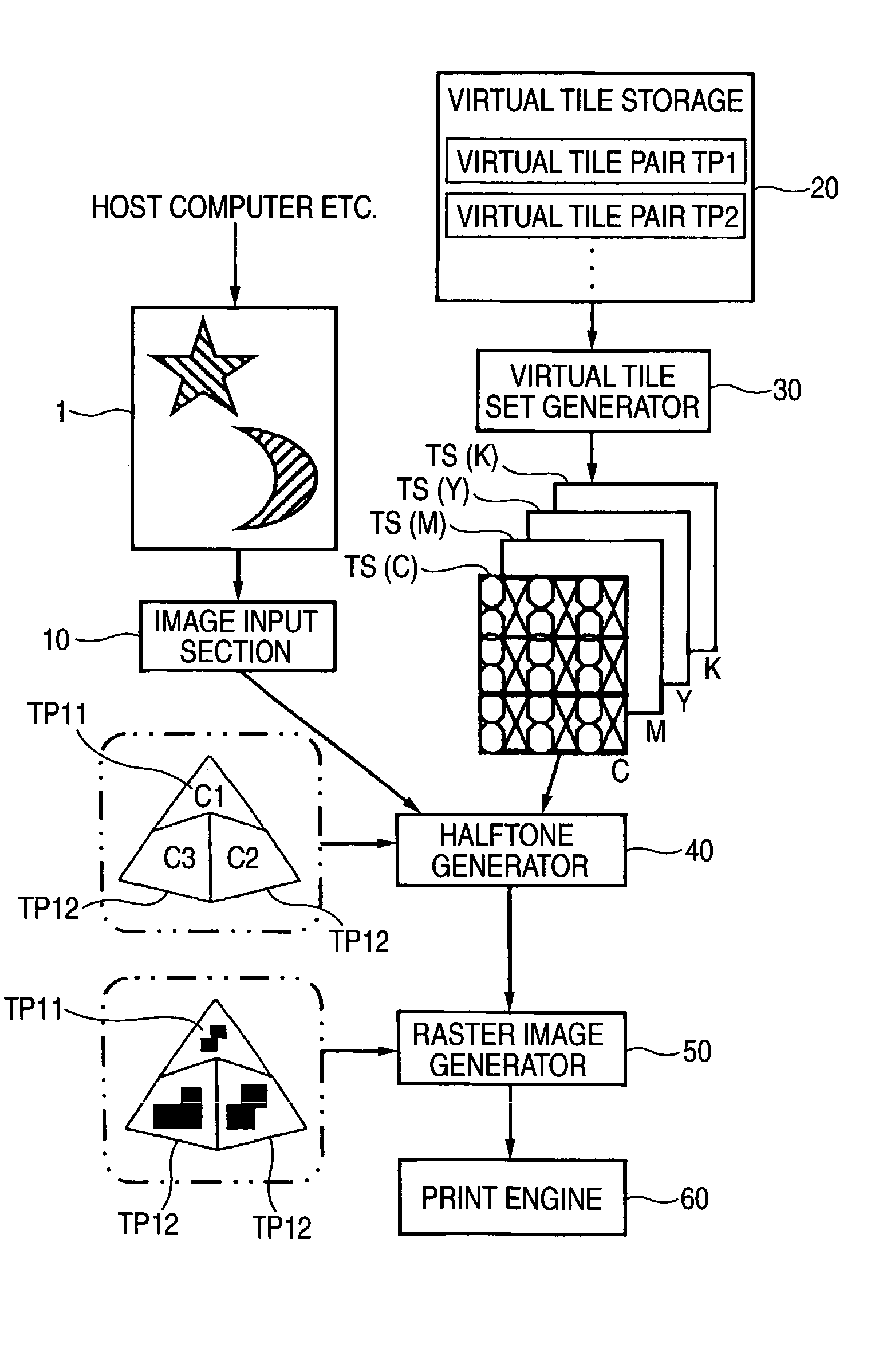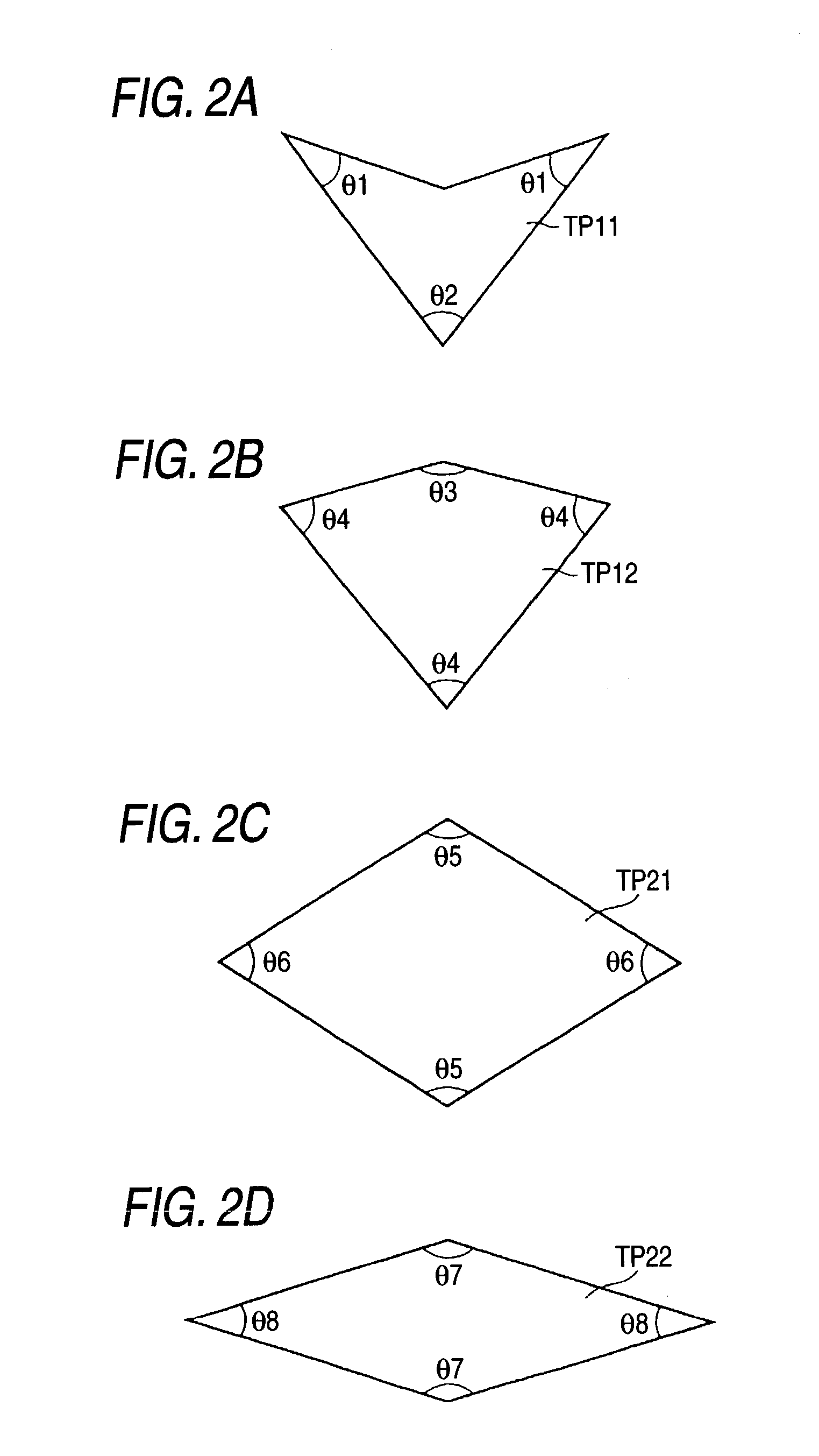Processor for image processing, method of processing image using the same, and printer incorporating the same
a processing method and image technology, applied in the field of image processing and image processing methods, can solve the problems of interference between patterns, difficulty in faithful regenerating, and difficulty in reproducing faithfully, and achieve the effect of reducing the occurrence of moiré fringes and high-quality multiple gradations
- Summary
- Abstract
- Description
- Claims
- Application Information
AI Technical Summary
Benefits of technology
Problems solved by technology
Method used
Image
Examples
first embodiment
[0081]First, the invention will be described with reference to FIGS. 1 through 22.
[0082]As shown in FIG. 1, a halftoning processor has an image input section 10; a virtual tile storage 20; a virtual tile set generator 30; a halftone generator 40; and a raster image generator 50, which will be respectively described later in detail.
[0083]The image input section 10 receives and stores an original color image input by way of an unillustrated host computer or the like. The host computer can be, for instance, a workstation, a personal computer, a portable information terminal, a cellular phone, a digital camera, a scanner, or the like. Here, the image input section 10 can receive an original color image directly from an image recording medium; e.g., a PC card or a memory card, rather than from the host computer.
[0084]The virtual tile storage 20 is formed within a storage section; e.g., memory or a hard disk drive. At least one pair of virtual tile sets TP, which will be described later, ...
second embodiment
[0126]With reference to FIG. 23, a color laser printer according to the invention will now be described.
[0127]A printer 80 which performs electrophotographic printing operation can receive an original image to be printed from a host computer 70 via a communication interface 81 or from a PC card 71 via a PC card interface 82. The printer 80 does not need to have both the interfaces 81 and 82. An original image can be input to the printer 80 via a digital camera or a scanner.
[0128]The printer 80 stores the thus-input original image into an input buffer 83. The original image held in the input buffer 83 is converted into a raster image by an image processor 85. The raster image is then written into an output buffer 84.
[0129]A print engine 90 reads the colors of raster images recorded in the output buffer 84 and prints the images through use of colors of image forming devices (the devices are constituted of photosensitive drums). The print engine 90 has a tandem configuration in which f...
third embodiment
[0135]With reference to FIG. 24, the invention will be described. This embodiment is characterized in that the entire surface of an original image is virtually covered with square virtual tiles of different sizes.
[0136]When the size of a virtual tile is larger than a predetermined value or when virtual tiles are allocated to an edge portion where a color tone or a density changes abruptly, the inside of the virtual tile can be further divided through use of a plurality of virtual tiles. In an illustrated example, a square virtual tile is divided into smaller squares (i.e., is divided in a fractal manner).
[0137]The size of a virtual tile covering an area of high-frequency component of the original image is reduced, thereby enabling performance of halftoning with higher image quality.
[0138]The invention is not limited to a case where a virtual tile is divided in a fractal manner. A virtual tile may be divided through use of a virtual tile having a shape different from that of the orig...
PUM
 Login to View More
Login to View More Abstract
Description
Claims
Application Information
 Login to View More
Login to View More - R&D
- Intellectual Property
- Life Sciences
- Materials
- Tech Scout
- Unparalleled Data Quality
- Higher Quality Content
- 60% Fewer Hallucinations
Browse by: Latest US Patents, China's latest patents, Technical Efficacy Thesaurus, Application Domain, Technology Topic, Popular Technical Reports.
© 2025 PatSnap. All rights reserved.Legal|Privacy policy|Modern Slavery Act Transparency Statement|Sitemap|About US| Contact US: help@patsnap.com



